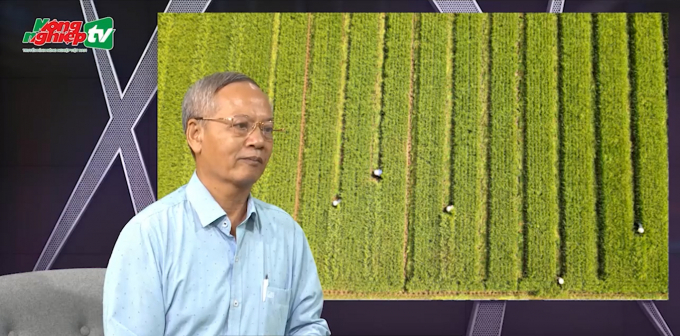November 25, 2025 | 11:20 GMT +7
November 25, 2025 | 11:20 GMT +7
Hotline: 0913.378.918
November 25, 2025 | 11:20 GMT +7
Hotline: 0913.378.918

Mr. Tran Xuan Dinh, Former Deputy Director of the Department of Crop Production.
In a recent interview with Vietnam Agriculture News, Mr. Tran Xuan Dinh, Former Deputy Director of the Department of Crop Production, shared his side of the story about the journey of hybrid rice in Vietnam.
When hybrid rice first entered Vietnam, I was working a local unit - the Agricultural Research Center of Thai Binh to be exact.
It’s common knowledge that there was a time when the relationship between Vietnam and China was quite “intense”, and so the border was closed. After our country’s implementation of renovation works and the occurrence of the Sichuan Conference, the relationship between Vietnam and China had been normalized. It was the start of strong exchanges at all levels, from central governments to mass organizations, particularly vibrant between the border people.
It was a period when we were suffering from the embargo, the economy was full of hardship, hunger and poverty, and we just got out of the bureaucracy subsidy system. The rice varieties then, as I remember back to the time I was at work in the province giving out instructions for production, were mostly long-duration varieties during the spring crop, for example the VN10 - a variety of Vietnam National University of Agriculture (previously the University of Agriculture I), or the M2 (Mexico 2) of the Field Crops Research Institute (FCRI).
In the next seasonal crops, several more varieties were released such as C70, C71 which were still belong to the medium-duration group, taking 160 - 170 days from sowing to harvest while the long-duration ones took 180 - 200 days. Later, we had some more varieties imported from the International Rice Research Institute (IRRI). They were NN22 and CR203 (or IR 8423) - the short-duration group.
Regarding hybrid rice’s entrance in Vietnam, the first path to mention was the people-to-people exchange in borderlands such as Quang Ninh, Lang Son, Cao Bang. Hybrid rice in China had grown quite prosperous at that time. As the relation between the two countries had been normalized which facilitated travel and trading, farmers were the first to receive those scientific advances. They bought the seeds from China, some were gifted and brought back to sow in terraces or fields laid in valleys and hillsides.
Those hybrid rice varieties were of top quality, which was a big surprise back then. The farmers planted them first, and news about them later reached the management teams, principally the provincial Departments of Agriculture. It was also to my knowledge that Quang Ninh brought this matter into view through the report in the Conference of Production organized by the Ministry of Agriculture.
After that, delegations and officers from the Ministry started conducting practical visits. The late Deputy Prime Minister Nguyen Cong Tan was a person full of passion for technological advances. He had also brought many technological innovations in crops, livestock, and forest varieties into Vietnam. It was thanks to “standard-bearers” that the entrance of hybrid rice could be realized and became an official program. That was how the era of hybrid rice started in Vietnam and created such wonder.
So when we came to see the things Quang Ninh had reported, it was clear that we were all in awe. It never crossed our mind that NN22 could be so incredible. NN22 grew up strong, the leaves came out beautifully. The plants bloomed firmly when ripen, gracefully stacked on top of each other.
Having witnessed such a hybrid rice field, from technical staff to leading cadres, all of the delegations were clearly astounded. After that, through the Ministry of Agriculture, following the instruction of the late Deputy Prime Minister Nguyen Cong Tan, the relationship between the two countries is increasingly strengthened especially in the agricultural sector.
The production of hybrid rice seeds was a very complicated technology. Back then, only China achieved success. While in the case of other countries, despite having an abundance of documents and scientific research works on hybrid rice genetics, since it was a self-pollinating plant with the male and female trait all within the rice flower, when the rice bloomed and the style lengthened, the plant had already self-pollinated.
The question was how to create heterosis. The rice plant must be sterile, meaning that the pollen must no longer be functional. That was the real important technology, and China had found it. Scholars in other countries such as the USA also researched this matter and had their own discoveries, but when the matter went down to replicating such technology to produce a large volume of hybrid seed, none other than China succeeded.
Translated by Samuel Pham

(VAN) Heavy rains make aquatic species more vulnerable to disease. Proactive water management and high-tech systems help farmers prevent outbreaks and protect yields.

(VAN) Greenhouses are shifting production mindsets in Binh Lu commune, enabling farmers to ‘weather the sun and rain’ and secure stable vegetable harvests throughout the year.

(VAN) Green transition is crucial for the Mekong Delta amid climate change and stricter standards, offering a path toward sustainability.

(VAN) Dong Thap promotes agricultural restructuring, forms large specialized farming zones, raises the value of agricultural products and develops toward ecological and high-tech directions.
/2025/11/22/4018-4-213342_747.jpg)
(VAN) The Mekong Delta Agricultural Experts Club has attracted 143 experts and researchers to participate in providing consultancy and contributing initiatives to the development of one million hectares of high-quality rice.

(VAN) Ca Mau’s development of OCOP products opens a path to increasing cooperatives value, helping boost income, expand markets, and affirm collective economy's role.

(VAN) Turning seemingly ordinary coconut shells into unique jewelry and artwork, Nguyen Bang Nhi spreads the value of local culture through her brand, Cocohand.